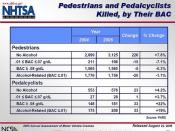A linear formula is defined as a mathematical function in which the variables appear only in the first degree, are multiplied by constants, and are combined only by addition and subtraction. A linear formula would be written as y=mx+b. The sets of data I will be determining linear or not are based upon the average rounded values for blood alcohol concentration (BAC) for people of different weights, according to how many drinks they have consumed. In this case the BAC is dependent of the amount of drinks one has guzzled down. (All my work for these problems are on a separate sheet of paper.)
When examining the data for BAC for a 120 pound person, I found the data to be linear. To know this I found the slope (rate of change) to see if is it consistent between all solutions of the formula. Slope is found by M(slope)=change in y divided by change in x.
I tested a few points from the table and found that the rate of change was the same between each set of data. This slope is .031; meaning after every drink there is a .031 increase in a 120 pound person BAC. A reasonable range for this model is all 0-.435. Because you can't have a BAC of negative, you will start out with zero drinks and a zero BAC. The Domain will be 0-14. If you have a zero BAC level, than you have had zero drinks, and in this case the domain is up until fourteen drinks because after fourteen drinks you are getting into dangerous levels.
After finding the slope, I can now figure out the equation. Because it is linear, I know that the equation will be in the form of y=mx+b. The slope is the "m" (.031) and the...


